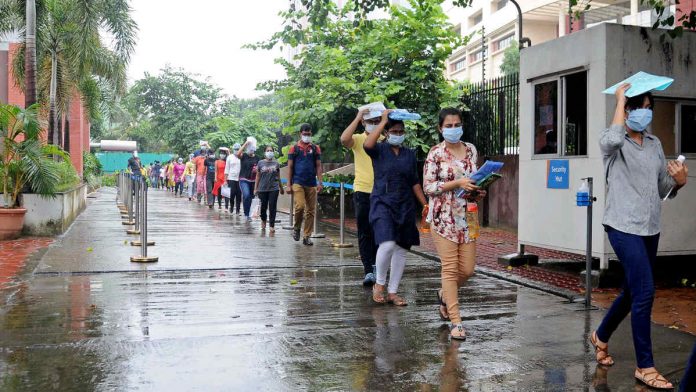No life, no hobbies, burnout, lost childhood — the price students pay for a prized IIT seat
No life, no hobbies, burnout, lost childhood — the price students pay for a prized IIT seaton Mar 23, 2021

Last year, 1.5 million students took the Joint Entrance Examination (JEE) to qualify for 13,000 seats in 23 IITs across the country — in other words, for each seat there were 115 aspirants.
So intense is the pressure and so gruelling is the preparation required that students as young as 14 start the process, often missing out on the simple joys of adolescence. Most give up extra-curricular activities, relationships with friends and peers, and all forms of entertainment to achieve the goal. By the time they achieve their aim, if they do, many realise they have lost out on social skills, ability to communicate easily with others (an attribute now known as soft skills), and of course, some part of their youth.
An IIT Delhi professor who has been teaching for the last two decades underlines this reality, saying when students come to them after two or three years of prep, they don’t even know how to behave socially.
“They have been cut off from society, they are unaware of current affairs, and are desperately in need of our induction programme for freshers where we try to re-orient them to society and the institute,” the professor said on the condition of anonymity.
This skill gap haunts them even when they graduate. Despite all the hard work engineering students put in, a survey conducted in 2019 found that 80 per cent of engineers “are not fit for any job in the knowledge economy and only 2.5 per cent of them possess technical skills in Artificial Intelligence (AI) that industry requires”. The skill gap between what they learn and what is required of them in their workspaces makes them unemployable.
Yet, in India’s shortage economy, where everything of value is kept in limited supply, there is no end to this annual exercise of competing in the JEE.
Like a 23-year-old machine learning engineer based out of Florida, who started his JEE preparation as early as Class 8, because his peers had started as early as Class 6. The engineer says he was so engrossed in his prep that he ignored basics such as good hygiene, good grooming, or even making friends.
“It took me an entire gap year before undergraduation to recognise and overcome these shortcomings,” he now says.
Or 29-year-old Shivam Narang, now working as a procurement manager with a prominent firm in Mumbai, who spent three years preparing for JEE. An “above average student”, he had to work 12-14 hours a day to crack one of the toughest exams in the world, making him lose out on much of his teenage years.
Source: https://theprint.in/1123
A basketball player in high school, Narang had to quit the sport after Class 10, once he started preparing for the engineering entrance, moving to Kota from Delhi, the coaching college magnet for all IIT aspirants.
“There is no room for hobbies – even playing your favourite sport for 30 minutes comes with a feeling of guilt,” Narang says. “Add to that the shift to an alien city with a competitive environment, which is so difficult to adjust to.” The constant pressure and fear of losing out led him to leave Kota. He took a break and took admission into a National Institute of Technology (NIT). “The loss of my values is what affected me the most. I am still very competitive and don’t feel comfortable working in a team. My personality changed, as did my body. I gained 35 kilos in a matter of months and my weight went up to 120 kilos,” Narang remembers.School, coaching, weekly exams
Some students such as Narang start preparing for the JEE at the age of 16, but others start as early as 12. These students, along with attending regular school, also go to coaching sessions and take weekly examinations. In the routine of coaching, school and tests, students claim that they miss out on important life skills, networking and overall personality development. The National Eligibility cum Entrance Test (NEET) for medical college admission, which has become a political hot potato in Tamil Nadu, so much so that the Dravida Munnetra Kazhagam (DMK) has promised to scrap it, is only marginally less difficult. In 2020, more than 1.5 million students appeared for it, a 15 per cent rise from the number of applicants in 2018. Of them, under 800,000 students were able to qualify for one of the 82,026 seats at 541 medical colleges across the country. After the introduction of the examination in 2017, several students committed suicide after failing to clear it. The DMK has promised to do away with the examination and put back in place the previous system of admission to medical colleges in the state, based on results of the state Class 12 board exam. The All India Anna Dravida Munnetra Kazhagam (AIADMK), meanwhile, has offered to provide additional training to NEET aspirants. According to coaching institutes, an average student spends 16 hours a week attending these extra classes, in addition to their regular school and studies. The annual financial cost of attending these sessions goes up to Rs 2 lakh. Pragya Bhardwaj, 35, who now practises as a gynaecologist in Bengaluru, took a three-year break after school to prepare for her medical entrance test. “I could not get an MBBS seat in the first attempt and it required two more attempts. Finally, after the third attempt, I got a seat in a reputed medical college in Karnataka. But the journey to get there was gruelling and took a toll on my personality, my health, mental well-being and social connections, almost everything,” Bhardwaj recalls. Students are allowed two attempts at JEE, but there is no cap for the number of NEET attempts — there is, however, an age bar of 25. The problem is not individual but systemic. As Dr Soumitra Pathare, director of the Pune-based Centre for Mental Health Law and Policy, puts it: “If you create a scarcity for something and push young students to try and get that scarce product in a restricted environment, it is bound to affect them mentally. “Premier institutes in our country have an admission rate of about 0.1 per cent, so what kind of outcome can you expect? No matter how resilient an individual is, when the system is rigged against them, it is criminal when the individual breaks down.” Parents go to the extent of disconnecting their children from the outer world to “help them focus”. Activities such as watching television, surfing the Internet, and participating in social events, sports and hobbies are placed at the bottom of the list of priorities. Shweta Garg, 50, a homemaker based out of Ahmedabad, says the two years her son spent preparing for the JEE meant the entire family put a pause on normal life. “Those two years were not only difficult for my son but for the entire family as well. To ensure that he was able to focus on boards and competitive exams, we removed the cable connection so that there were zero disturbances for him. Family vacations and social events were given a skip and a serious environment was created in the house,” she told ThePrint. Yet, her son was unable to make it to an IIT. Garg sidesteps that, saying she thinks her son matured during the period. Although he missed meeting his friends and cousins, he knew he had to prioritise.The role of coaching classes
Coaching institutes make things worse for aspirants. Kishore Kumar, an IIT Kharagpur alumnus based out of Delhi, who has been coaching JEE and NEET students for the past 11 years, says the institutes create an atmosphere where students are divided into batches based on their performance. If a student spends five years training in a ‘low-performing’ batch, it conditions the child to not think of himself/herself beyond a low-performing student. He/she will then hesitate to take part in group activities or anything else to assist his/her personality growth. Anand Kumar of ‘Super 30’ fame says he ensures the focus of his students is on enhancing their creativity so that they don’t become another cog in the wheel. “Most of my students are from rural backgrounds with poor financial stability,” he said. “Whoever shows a flair for scientific learning turns up for coaching. My focus largely remains on enhancing the ability of students to grasp concepts. They need to learn about real-life applications of their studies to ensure success even after getting into an IIT.” Speaking about the types of skills he imparts, Kumar said, “Instead of just going by textbook examples, I try to relate the concepts with their real life situations. This helps students understand things better. I also need to prepare them for a massive shift, from a rural setting to a college, and then a formal workplace. To do so, we pick examples of world leaders with humble beginnings and read from their biographies.” Of the 510 students he has trained over 19 years, 410 have got into IITs, NITs and other notable engineering colleges. Some experts even question the necessity of coaching classes. Meeta Sengupta, founder of the Centre for Education Strategy, a Delhi-based think tank dealing in education policy issues, said: “Although experts say that coaching helps students take the exams, it is not healthy for children. They lose the space for discovery and innovation during the course of such training.” Several students, because of the lack of an outlet and no mindspace for anything other than studies, experience a burnout by the time they reach a university. This leads to several mental health problems. A mental health expert with an IIT, who chose to remain anonymous, said, “The most common problem among IIT students, who have all their lives been seen as high achievers, is the sense of a vacuum. It can also be called an ‘existential crisis’. After years of rigorous training, students start searching for a deeper meaning in life. This can either happen because of anxiety issues or depression, or exacerbate them as well.”
Coronavirus
Education
Education News
Frontlist Education
Frontlist India news
Frontlist Latest news
IITs
Joint Entrance Examination (JEE)
Latest news



.jpg)






.jpg)

.jpg)
.jpg)
.jpg)
.jpg)

.jpg)

.jpg)








Sorry! No comment found for this post.